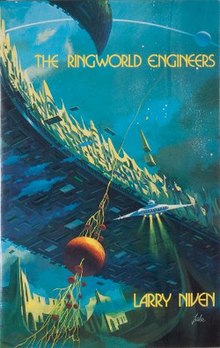The Ringworld Engineers
 First edition | |
| Author | Larry Niven |
|---|---|
| Cover artist | Paul Lehr |
| Country | United States |
| Language | English |
| Series | Ringworld storyline from Known Space |
| Genre | Science fiction |
| Publisher | Phantasia Press |
Publication date | 1979 |
| Media type | Print (Hardcover & Paperback) |
| Pages | 355 pp |
| ISBN | 0-932096-03-4 |
| OCLC | 5286215 |
| 813/.5/4 | |
| LC Class | PZ4.N734 Rj PS3564.I9 |
| Preceded by | Ringworld (1970) |
| Followed by | The Ringworld Throne (1996) |
The Ringworld Engineers is a 1979 science fiction novel by Larry Niven. It is the first sequel to Niven's award-winning Ringworld and was nominated for both the Hugo and Locus Awards in 1981.[1]
Origin
In the introduction to the novel, Niven says that he never planned to write more than one Ringworld novel, but that he did so, in a large part, due to fan support. Firstly, the popularity of Ringworld resulted in a demand for a sequel. Secondly, many fans had identified numerous engineering problems in the Ringworld as described in the novel. A major problem being that the Ringworld, being a rigid structure, was not actually in orbit around the star it encircled and would eventually drift, resulting in the entire structure colliding with its sun and disintegrating. In the novel's introduction, Niven says that MIT students attending the 1971 World Science Fiction Convention chanted, "The Ringworld is unstable! The Ringworld is unstable!" Niven says that one reason he wrote The Ringworld Engineers was to address these engineering problems.
Plot summary
The plot of the novel centers on the instability of the Ringworld. The recently-deposed Hindmost, leader of the Puppeteers, abducts the human Louis Wu (who has become a wirehead) and kzinti Chmeee (previously known as "Speaker-to-Animals"). Both were part of the Ringworld exploration in the first novel. The Hindmost hopes to acquire Ringworld technology that he hopes will help him reacquire his position as leader.
In the course of the novel, Louis and Chmeee set forth in the Hot Needle of Inquiry on an exploration of the Ringworld in order to learn where the creators of the Ringworld may have built a control or repair system. In their travels they meet a number of the hominid species that have evolved on the Ringworld. They also learn more about the "maps" of various known space worlds that are located in one of the Ringworld's great oceans. These full-size maps include, among others, Kzin, Earth, and Mars.
It is on the Map of Mars that the party finds the Ringworld control room, located in a vast maze of rooms contained in the hollow space under the map. In order to create the rarefied atmosphere on Mars, the Map of Mars was built to an altitude 20 miles (32 km) above the main Ringworld surface creating a 1,120,000,000-cubic-mile (4.7×109 km3) cavity. The Control Room contains living space for thousands of Pak Protectors, as well as space to grow the "Tree-of-Life" plants to support this many Protectors. Other rooms in the cavity support such features as the "Meteor Defense System", which uses the superconductor grid embedded in the scrith foundation material to manipulate the magnetic field of the Ringworld's sun to create a solar flare; it uses this to generate a powerful gas laser, which is capable of destroying everything in its path.
In the course of finding the control room and saving the Ringworld, the party learns what became of Teela Brown, who had been left behind after the exploration twenty years earlier led by the Puppeteer, Nessus.
References to other Known Space works
Apart from the obvious references to the preceding novel Ringworld, The Ringworld Engineers also draws upon ideas elaborated in Niven's 1973 novel Protector for Teela Brown's ultimate fate.
Awards and nominations
Ringworld Engineers was nominated for both the 1981 Hugo[2] and Locus[1] Awards in the Novel Category.
Publication history
- 1979, USA, Galileo Magazine, 4 part serialization July 1979, September 1979, November 1979, January 1980
- 1979, USA, Phantasia Press, ISBN 0-932096-03-4, Boxed edition, limited to 500 copies
- 1980, USA, Holt, Rinehart, and Winston, ISBN 978-0-03-021376-2, Hardcover
- 1981, USA, Ballantine Books ISBN 978-0-345-26009-3, Paperback
- 1985, USA, Ballantine Books ISBN 978-0-345-33430-5, Pub Date 12 November 1985, Paperback
- 1997, USA, Ballantine Books ISBN 978-0-345-41841-8, Pub Date 23 June 1997, Paperback
- 1992, UK, Orbit Books ISBN 978-1-85723-111-3, Pub Date 12 Aug 1982, Paperback
Notes
- ^ a b "1971 Award Winners & Nominees". Worlds Without End. Retrieved 2009-07-20.
- ^ "The Locus Index to SF Awards: 1981 Hugo Awards". Retrieved 2008-04-16.
External links
- Ringworld Engineers at Worlds Without End
